If any year can rival 1971 or 1982 as the most seminal in the history of Walt Disney World, it would be 1989. A new theme park, water park, and entertainment district added three new, separately ticked offerings to the resort. The company also did this without neglecting their existing assets, as both Magic Kingdom and EPCOT Center would see new attractions. This was a point at which a vacation at Disney World could easily become a week-long event. The expansion of the resort was rolling as fast as they could build.
Magic Kingdom
Significant changes to the Magic Kingdom could be seen the second you entered Town Square. The Disney-MGM Studios Preview Center returned to being the Walt Disney Story attraction, and on July 24, Tony’s Town Square Restaurant opened in the former home of the Town Square Café.
In Adventureland, the Crow’s Nest, sponsored by Kodak, was sectioned off from the rest of the Caribbean Plaza shops in its own stand-alone location. George H. W. Bush was added to the Hall of Presidents, but the show was otherwise unchanged from 1971. Sleepy Hollow’s menu now boasted the infamous “handwiches”, and the Umbrella Cart and The Courtyard joined the Liberty Square shop line up across from Sleepy Hollow. In Tomorrowland, a film kiosk featuring glow merchandise appeared near the Skyway Station.
On January 3, If You Could Fly closed its doors to be replaced by Delta Dreamflight on June 23, with an official dedication on June 26. The new attraction used the same track layout, but instead of highlighting locations the sponsor serviced, it offered a history of aviation.
Guests entered through an airport themed queue, over a colorfully lighted jet bridge into a modern airliner facade. The load area featured a large mural of an early airfield. The first scene of the ride was a spinning pop up book of early flying contraptions, which led into a comedic scene with mostly flat elements showcasing early barnstorming days of powered flight. Next, guests moved through a barn where an airman is hanging from a parachute after a crash, and then past real footage of wing-walkers and stunt flights.
Riders would “board” the Global Clipper, a flying boat in San Francisco for the “era of air travel.” This was a series of fully three dimensional sets in front of backgrounds of Tokyo and Paris. The WEDWay Peoplemover would still look in on this set, though some of the other windows were now blacked out. Guests on Dreamflight would then be “sucked” into a jet engine to “prepare for supersonic takeoff” to the future. This was accomplished by entering an engine façade with a spinning light and smoke effect, a room that still exists in Buzz Lightyear’s Space Ranger Spin, albeit the light effect has been broken for years now. A massive scene with a giant “speed tunnel” would use projections to simulate flight through real and computer generated landscapes and cloudscapes before flying through a computer generated city of the future. The final scene before unload once again featured a pop up book with turning pages, now showing skylines of New York and London. The attraction also received its own memorable theme song by Bob Moline.
On October 1, the Character Hit Parade debuted. The parade ws led off by the marching band and the steamboat float with Chip and Dale, Roger Rabbit, then the Pooh float models after his tree home.

The honey pot headed Pooh bear was now replaced with a more modern version. Next came the Alice in Wonderland units, with a teapot and the gazebo float. After that, gets would find the Country Bears and Davy Crockett, followed by Hook and Smee in their small boat, along with Tic-Tock the crocodile.
The next unit was Snow White on the mill float and Cinderella’s horse drawn carriage. Mary Poppins, Bert and the chimney sweeps followed, with a Pinocchio unit tailing them in Stromboli’s wagon. BMX riders and skaters accompanied Goofy on his float. The grand finale float was the castle float loaded with Mickey, Minnie, and Gummi Bears characters. At some point during the parade’s run, a Jungle Book unit designed after King Louie’s ruins was inserted between the riverboat and Pooh units and the DuckTales characters joined the castle float.
EPCOT Center
World Showcase saw several small changes. In Norway, the shops were consolidated under just the Puffin’s Roost name. In Germany, the Sommerfest quick service opened serving pretzels, desserts, beer and wine. Also, Porzellanhaus became Die Welhnachts Ecke, the Christmas shop, and Kunstorbeit in Kristol became a more permanent Arribas Brothers location. In Italy, Fine Leather Goods was renamed again, this time to La Bottega Italiana. Merchandise and food carts were added outside the American Adventure, or once again at least added to the maps as locations. In Japan, the Mitsukoshi kiosk across from the main department store opened. The cookware shop was renamed Tout Pour Le Gourmet in France.

The long planned life and health pavilion, Wonders of Life presented by MetLife, finally opened October 19. Guests would approach the golden dome structure past a 72 foot tall DNA helix.

Once inside There were a variety of attractions and exhibits. The anchor attraction was Body Wars, a simulator. Four shows (Cranium Command, The Making of Me, Goofy About Health and the AnaComical Players) rounded out the attractions, while several interactive exhibits, a snack bar, and a shop rounded out the offerings.
Body Wars was built around the same motion simulator system as Star Tours, which had opened at Disneyland in 1987. Guests would be taking a tour of the MET facilities (Miniature Exploration Technologies) in order to take a trip into the human body after being miniaturized. Once inside one of the four 40 person ride vehicles, guests were to rendezvous with Dr. Cynthia Lair (Elisabeth Shue) to examine a splinter. After the doctor is accidentally sucked into a blood vessel, the guests are taken on a rescue mission by Captain Braddock (Tim Matheson), the pilot. After completing the rescue, the ship, Bravo 229 is out of power and has to be jump-started by neurons in the brain. The wild ride takes place through the heart and brain, making the guests the first people to enter those parts of the body. The film portions were directed by Leonard Nemoy of Star Trek fame.
Cranium Command was a multimedia show featuring live action, animation and audio animatronics. Guests followed a brain pilot rookie, Buzzy, through his first day as his commanding officer, General Knowledge, insults and pushes him to do a better job. Buzzy (Scott Curtis) is chosen to pilot Bobby (also Scott Curtis), a 12-year-old boy and the most unstable craft in the fleet. As he takes Bobby through a day full of bullies and a love interest, the animatronic Buzzy commands the other parts of the body: the Left and Right Brains (Charles Grodin and John Lovitz), the Stomach (George Wendt), the Adrenal Gland (Bobcat Goldthwait), the Left and Right Ventricles (Dana Carvey and Kevin Nealon). The attraction was most notable for its cast (who were all famous comedians at the time, 3 in fact active cast members on Saturday Night Live in 1989), as well as a meta sense of humor. The show also features the voice talents of Corey Burton as General Knowledge.
The Making of Me was a 16 minute film, in which Martin Short tells the story of his parents meeting and his birth. The film also explains the process of fertilization between sperm and egg cells in an animated segment that lasts about 1 minute and 30 seconds, as well as fetal development.
According to producers, the film was “…somewhat a departure for a Disney attraction”, and mentions that the film “may elicit controversy” in regards to the issue of abortion; fortunately, the intent was “to not walk into the teeth of the (abortion) issue.” Given that birth and conception is a sensitive issue around families, an advisory sign was placed near the entrance to the theater, in order to advise parents to decide whether the film is suitable for their children.
Goofy About Health used segments from old Goofy shorts with new narration, shown on multiple screens to highlight unhealthy living habits.
AnaComical players was a small, live theater show using a combination of sketch and improv comedy to talk about different health issues.
The exhibits included:
- The Wondercycles – stationary bikes where guests could ride while watching video tours of locations including Disneyland
- The Sensory Funhouse – a series of elements designed to test and trick your senses
- The Coaches Corner – where guests could have golf, baseball or tennis swings analyzed by Nancy Lopez, Gary Carter, and Chris Everett on screens
- Frontiers of Medicine – displays of new medical breakthroughs
- Met Lifestyle Review – interactive consoles that told guests how to live healthier.
There was a small gift shop called Well & Goods Limited and a snack area serving “guilt-free goodies.”
The Disney-MGM Studios
May 1 saw the official opening of Disney World’s third theme park, even if it wasn’t meant to be a full day experience. The park opened with only six attractions, though more would appear by year’s end. The park was loosely divided into lands: Hollywood Boulevard, the Backlot Annex, and Lakeside Circle. The Backstage Studio Tour and The Magic of Disney Animation were broken out by themselves so the individual elements could be listed as attractions in the map. Though the corporate dedication was on April 29, and The Wonderful World of Disney aired the opening special on April 30. The actual ceremony on May 1 included Michael Eisner, Bob Hope, Steve Allen and Anette Funicello and many others, along with a band and dancers.

The entrance to the park was similar to what it is today, minus the security structures. The entrance evokes the now-defunct Pan Pacific Auditorium in Los Angeles, an entrance that would later be replicated for Disney California Adventure as well.
The first thing guests encountered inside the park was the Crossroads of the World. Past that, and facing down Hollywood Boulevard guests would have a clear view to the Chinese Theater. On their left side in the entrance plaza were Movieland Memorabilia Souvenirs and Sundries and Sid Cahuenga’s One-of-a-Kind, selling authentic movie memorabilia and autographs. On the opposite side was Oscar’s Classic Car Souvenirs, and the stroller and wheelchair rental, Oscar’s Super Service.
On the left side of Hollywood Boulevard sat the main shop, Mickey’s of Hollywood, and past that guests could find Keystone Clothiers, Lakeside News (a comic book shop), and Sights & Sounds sponsored by Selah, where they could record their own music videos.
On the right side of the street, guests would pass The Darkroom presented by Kodak (the camera shop), Cover Story (where guests could have their picture put on magazine covers), Celebrity 5 & 10 (clothes and souvenirs), Sweet Success (a candy shop), & Pacific Electric Pictures (personalized videos and merchandise).
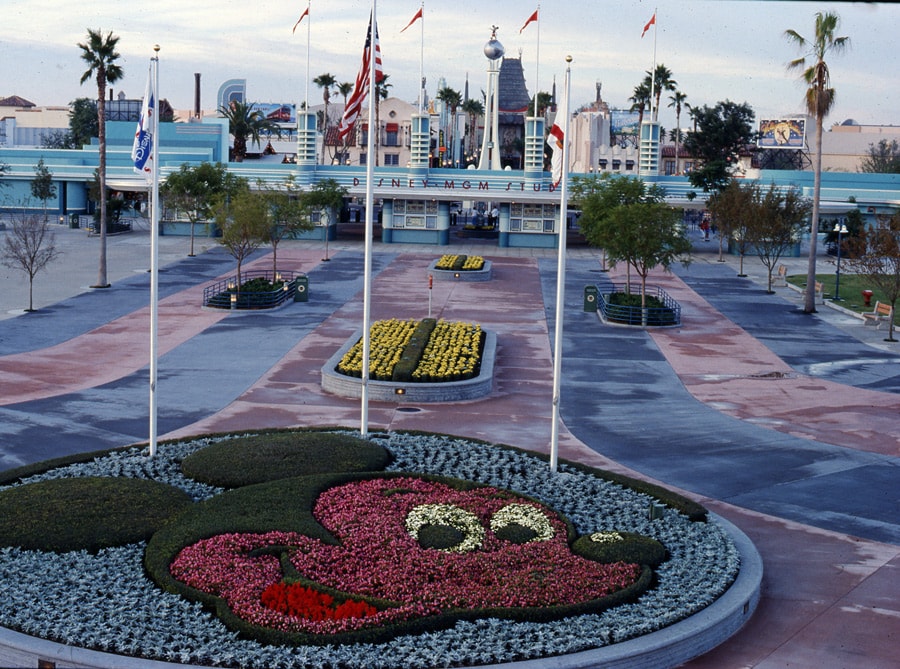
The Theater of the Stars sat at the intersection with Sunset Boulevard is now. The open air Hollywood Bowl themed amphitheater originally housed “Hollywood! Hollywood!”, featuring dancers and Disney characters recreating classic style movie scenes. The show lasted through August before closing. The theater would also host the “Star Conversation” with the “Star of the Day”, a program that would bring in a celebrity to parade down Hollywood Boulevard in the Star Motorcade, take part in a Handprint Ceremony at the Chinese Theater, and give a presentation to guests.
Hollywood Boulevard was the hub of the park’s entertainment with Streetmosphere, the Hollywood Brass band and the Screen Extras Band appearing daily. The Hollywood Brown Derby was, like today, the park’s premier table service restaurant, and Hollywood and Vine was a cafeteria. Starring Rolls, a bakery, rounded out the restaurants on Hollywood Boulevard.

The Chinese Theater hosted the park’s marquee attraction, The Great Movie Ride. Originally developed as a Future World pavilion, the concept (and Michael Eisner’s alleged attendance at a meeting where Universal presented their plans for a Florida park to Paramount) became the genesis for the park.
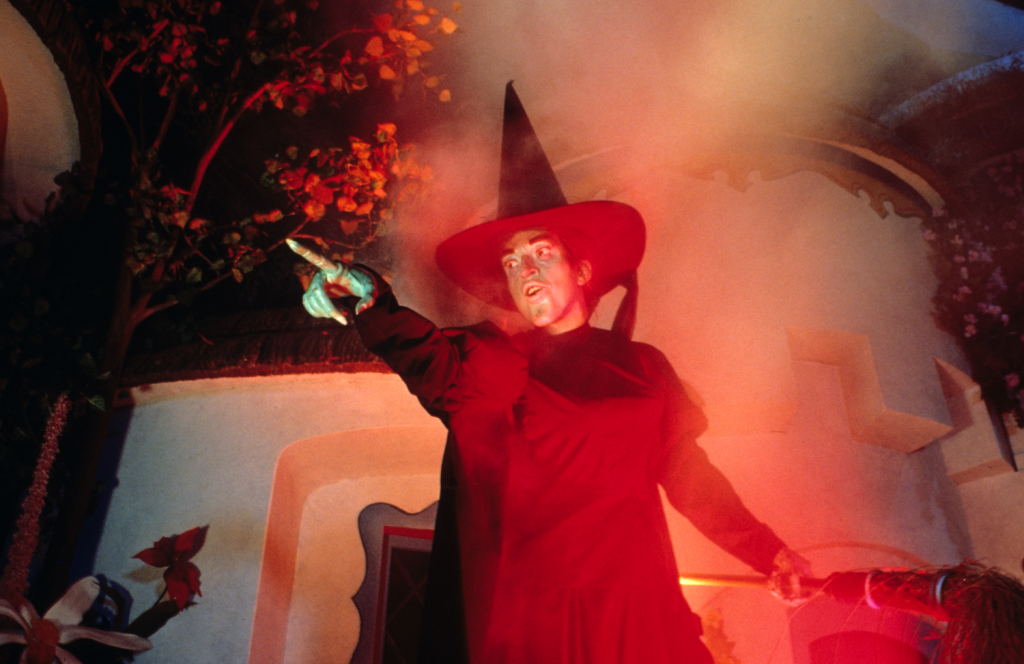
The 22-minute ride featured live cast member hosts that would narrate the show as it passed through scenes from classic and contemporary films. The host would then be displaced by either a gangster or wild west bank robber. An automated narration would take over through scenes featuring the movie Alien and Raiders of the Lost Ark. The hijacker would leave the car to steal a jewel from a temple, but be warned away from it by the temple priest. After ignoring the warning, the robber would be enveloped in smoke and replaced with a skeleton and the priest is revealed to be the original host. After passing other scenes, including Casablanca and Tarzan, guests would get to the Fantasia scene. This was originally intended to be a Wizard of Oz twister, but last-minute licensing disagreements with MGM forced some changes. While the ride did get an amazing Oz scene (including the first A-100 class animatronic, the Wicked Witch), it was supposed to be part of a trio of scenes including a scene in the Wizards throne room with the supposedly dead hijacker emerging as “the man behind the curtain.” Another original finale idea featured several other characters from across cinema history like R2-D2, C3-P0, and even the Ghostbusters before the deal fell through and the IP ended up at Universal Studios Florida, but instead we received a film montage.

While the Great Movie Ride was the signature attraction, the true heart of the park at this time was the Backstage Studio Tour. This two hour experience began with the tram ride that boarded in what would become the Animation Courtyard. Once aboard the tram guests would listen to a live narrator as they were taken past the Costuming and Scenic Shop areas that could be seen through windows.
Next guests would drive through Residential Street which featured facades used in TV and movies, most notably homes from the Golden Girls and Empty Nest. After that, they would see vehicles from famous productions including the ship from Flight of the Navigator, a sail-barge skiff from The Return of the Jedi and a Snowspeeder from The Empire Strikes Back. The show piece of the tram tour was next, Catastrophe Canyon. Here, guests would be taken on to a supposed live set to watch an effects demonstration featuring an exploding oil tanker as well as flood and earthquake effects. The tram tour would end after a trip through the facades of New Your Street before dropping guests off for the walking portion of the tour.


Before starting the walking tour, guests would have a chance to use the restrooms, eat at the Studio Catering Company, shop at The Loony Bin, or have a photo “opportoonity” with cartoon characters.
The walking tour started at the Water Effects Tank where guest volunteers would be used to film two scenes involving a WWII sub and a rogue wave ala the Poseidon Adventure. Many of the effects demonstrations would be focused on a film, The Lottery, starring Bette Midler and directed by Gary Marshall. The film was shot earlier in the year at the studios.
The next area was the Special Effects Workshop and Shooting Stage, featuring models and demonstrating composite shots using guests riding a version of the giant bee from Honey, I Shrunk the Kids. Next were a series of three soundstages that would feature a rotating cast of real productions. The final demonstrations would be in Post Production Editing and Audio, before guests would finish in the Walt Disney Theater that would host previews of upcoming films, including dailies from projects shot in the park.

Now back in the entrance courtyard, guests could shop at The Disney Studio Store or grab a bite to eat at the Soundstage Restaurant, or its accompanying Catwalk Bar. The Soundstage restaurant was a quick service restaurant themed to several Disney/Touchstone films over the years, but it was themed to 1988’s Big Business when it first opened. The Catwalk Bar was literally in the catwalks above the restaurant decorated with the rigging and lighting one would expect above a soundstage. These locations are now home to Disney Junior Dance Party and Club 33.


Nearby was the Disney-MGM Studios Animation Tour. The tour started with the Walter Cronkite and Robin Williams hosted Back to Never Land film. Cronkite describes the animation process while Williams is turned into one of the lost boys for a Neverland sequence.
After this, guests would be taken through the different steps of the animation process: Story, Animation, Clean Up, Effects, Backgrounds, Photocopying Process, Paint Lab, Inking and Painting, Animation Camera, and Editing. The finale took place in the Disney Classics Theater featuring a montage of Disney moments from throughout the years. The Animation Gallery Shop sold cels, reproductions, and other collectibles.
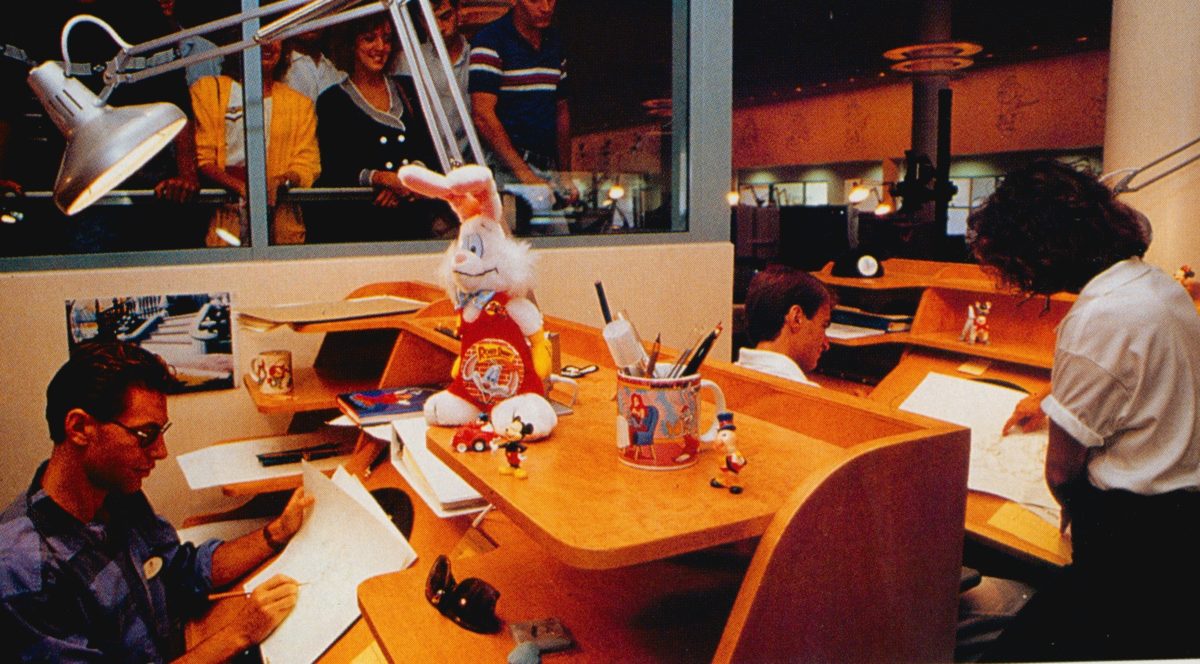
In the Lakeside Circle (Echo Lake) area, Sony sponsored two attractions: Superstar Television and The Monster Sound Show. In SuperStar Television, Cast Members and guest volunteers would be filmed interacting with real television footage. Scenes included a news cast covering the opening of Disneyland in 1955, the chocolate conveyor scene of I Love Lucy, General Hospital, The Ed Sullivan Show, Bonanza, Gilligan’s Island, the moon landing, the Three Stooges, Cheers, The Golden Girls, SportsBreak, The Tonight Show with Johnny Carson, and Late Night with David Letterman. Scenes would be shot both on and back stage and displayed composited on overhead screens and some of sets on the stage would rotate on a devolving platform.
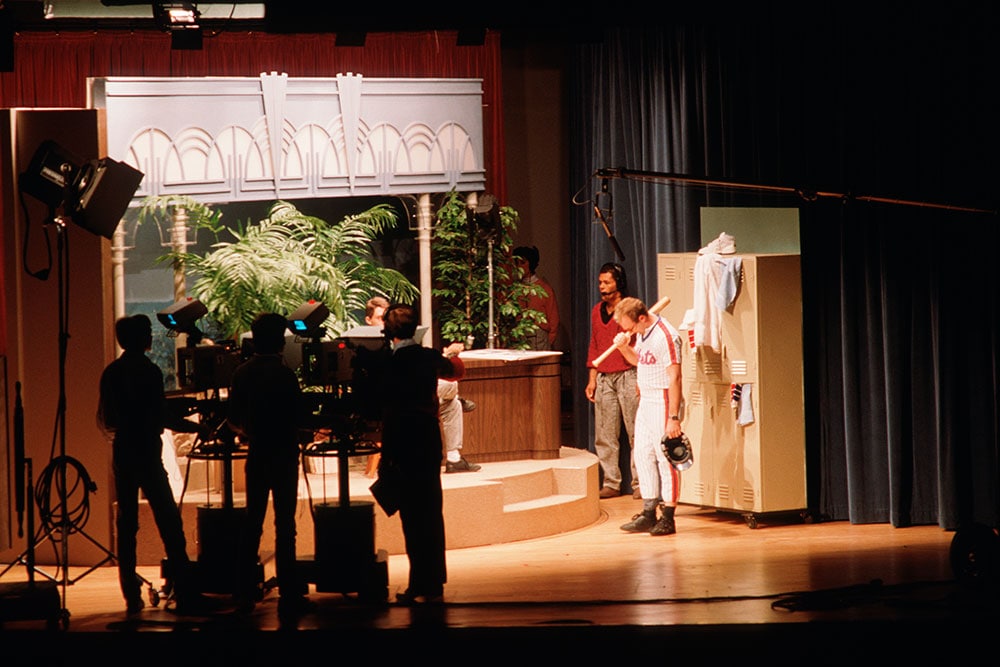
At the Monster Sound Show, on stage guest volunteers would be taught by hosts to act as Foley artists adding sound effects and vocals to a film starring Chevy Chase and Martin Short. The post show, the SoundWorks featured interactive booths where guests could add effects to Disney films, like the headless horseman’s hoof steps. The area also featured the 3-dimensional sound booths, Soundsations. Inside, guest would put on headphones to experience the audio adventure of a new Disney studio executive on his first day: getting a haircut, listening to a movie pitch, and meeting Mickey Mouse, all presented in extremely realistic audio.
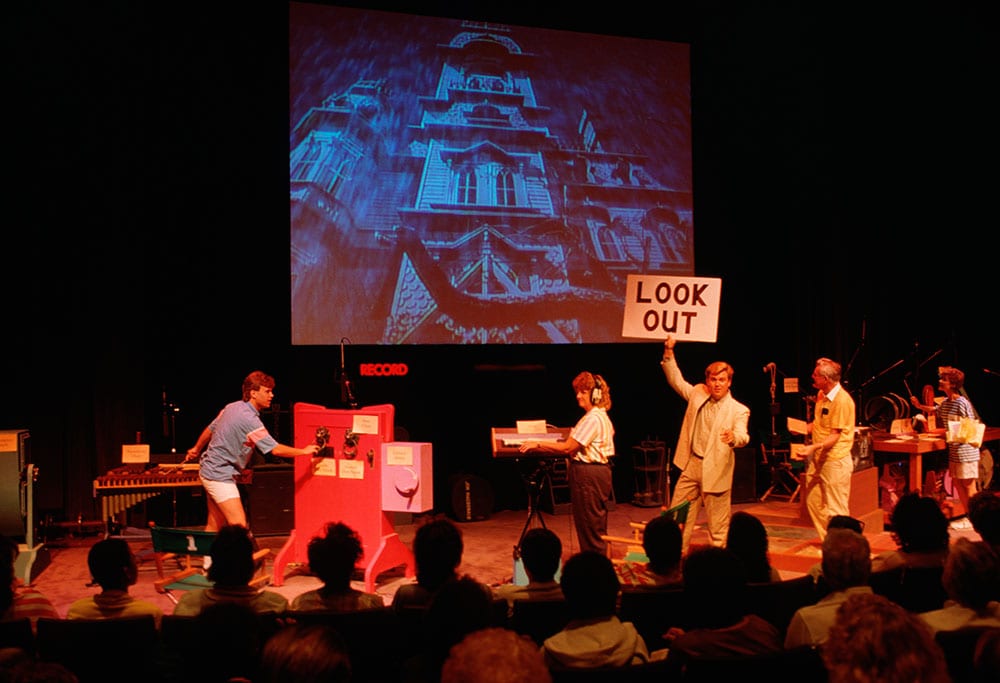
In this area guests could dine at the quick service Backlot Express or at Min and Bill’s Dockside Diner, grab a dessert at Dinosaur Gertie’s Ice Cream Extinction, have a drink at the Tune-In Lounge, or eat in a classic sitcom kitchen at the 50’s Prime Time Café, all of which existed almost as they do today. Golden Age Souvenirs featured TV and Disney Channel themed merchandise, and while the attraction was not yet open, Star Tours’ exit shop, Endor Vendors, was open on May 1.

The Studios received its first major addition on August 25th, The Indiana Jones Epic Stunt Spectacular. The major show elements: the ball chase scene, the fight at the plane and the big fight at the market were all in the show, as well as the use of volunteer extras. While the August date was the grand opening, the show was open to guests in technical rehearsal at least as far back as the second week of June, if not earlier.
Star Tours opened at the Studios on December 15th, making it the third iteration of the attraction. The original version of the ride saw guests entering through a set that would transition into the world of Star Wars. After viewing a safety video full of various aliens, guests boarded one of six Starspeeder 3000s for their trip to the forest moon of Endor. Due to a malfunction, your pilot, Captain RX-24 (or Rex), ends up fleeing comets and the Empire before joining an assault on the 3rd Death Star. Yes, a 3rd Death Star since this took place after the only Star Wars films released up until that point. After a near crash landing guests end up back where they started. The attraction was sponsored by M&Ms.

Pleasure Island
In response to the popularity of the entertainment venues at Church Street Station in Downtown Orlando, Disney had decided to build its own late night adult entertainment venue. The complex was targeted toward adults, requiring anyone under 18 to be accompanied by a parent or guardian. While the shops were open during the day, the venues only opened with the cover charge in the evening, originally 6 PM, one admission would include all the clubs and cost $14.95 for an adult. The complex opened officially on May 1, likely to give guests something to do after the shorter day at the Disney-MGM Studios. The whole complex was designed around the backstory of Merriweather Pleasure, a businessman and adventurer who operated the area as a sail making business. The clubs, shops and restaurants were built in his abandoned factories and warehouses.

The six acre complex featured seven clubs at opening. Starting clockwise from the north west corner of the the complex you could find The Neon Armadillo Music Saloon, a country bar. Next to that sat The Adventurer’s Club and the Avigator’s shop featuring branded fashion. Next came Suspended Animation and YesterEars stores selling Disney art and retro/vintage merchandise respectively. Here was also Sweet Surrender, an ice cream shop and bakery. Across an alley was Doodles, a t-shirt store, and XZFR Rockin’ Rollerdrome, which would allow guests to roller skate to rock music. Next to that was the Fireworks Factory, a barbecue restaurant. Portobello Yacht Club served Italian food, and the Empress Lilly and the Baton Rouge lounge were made part of Pleasure Island.
The south bank of buildings featured Merriweather’s Market, a counter service restaurant. The market was named after Merriweather Pleasure, the island’s fictional founder. This building also held The Mouse House, selling standard Disney merchandise and D-Zerts, a coffee shop and bakery. The Island Depot sold Pleasure Island themed merchandise and rented strollers and wheelchairs. Videopolis East opened alcohol free and played music targeting a younger crowd. Mannequins Dance Palace (Now Morimoto Asia) featured professional dancers and a rotating dance floor. Changing Attitudes was a modern clothing and accessory shop and Hammer and Fire sold jewelry and gifts. Guests could lip sync their own music videos at SuperStar Studios and pose for magazine covers at Cover Story. The Comedy Warehouse featured a stable of stand up comedians. The AMC Pleasure Island 10 had actually opened a few months before on December 16, 1988.
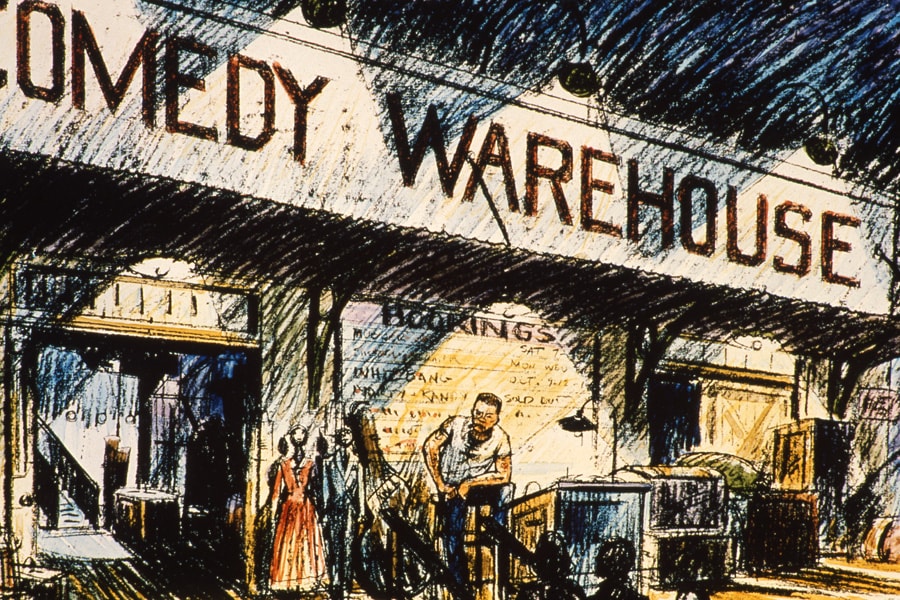
Developed primarily by Joe Rhode and Roger Cox, The Adventurers Club was definitely the most Disney style entertainment at Pleasure Island. Tied into the fictional story of the island told through plaques scattered around the various buildings, the setting for the club was locked into 1937, on the open house night where the club was open to new members. The club was divided into five areas: the Zebra Mezzanine, which served as the entrance and overflow area, the Main Salon a round room where most guests would congregate between shows, the Library which hosted the main stage shows, and the Mark and Treasure rooms that served as both offshoots of the main lounge and hosted secondary performances. Various characters, portrayed by excellent improv comedians, would interact with guests throughout the night and perform a series of shows telling the story of the club. Each of the rooms was extensively decorated with artifacts, many of which could be brought to life and puppeteered by the actors. The main shows included the Welcome Party, The Balderdash Cup (where the characters competed for Adventurer of The Year), different versions of a radio show and sing-a-long, and always ended with the Hoopla. Each of the shows was a different balance of scripted entertainment and improv.

Typhoon Lagoon
River Country had been a hit since day one and was often filled to capacity. Meanwhile, just a few exits up Interstate 4, Wet and Wild had established itself as a more modern water park. Disney’s answer was to build Typhoon Lagoon, with more slides, heavy theming and the world’s largest wave pool.
Of course, the park had to have a backstory: Hurricane Connie swept a bunch of debris which was used to rebuild the Leaning Palms resort and depositing the park’s icon, the Miss Tilly on top of Mount Mayday. This would overlook the Surf Pool which would generate 6 foot waves every 90 seconds. This pool served as the center of the park and was surrounded on most sides by a sandy beach. For those looking for a calmer experience, there were two attached wading pools Blustery Bay and Whitecap Cove.
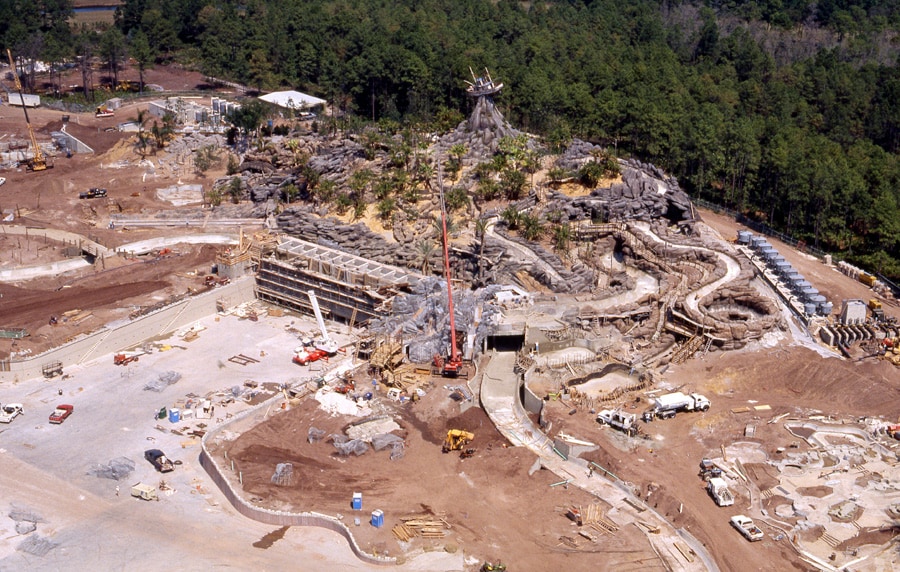
Before getting there, guests would pass through a tropically decorated area and the only shop, Singapore Sal’s Saleable Salvage, before getting to the locker and shower area. They would also have to pass over the 2000+ foot lazy river, Castaway Creek that encircles the center of the park.
There were also plenty of slides for adventure seekers. The Humunga Kowabunga were three tall enclosed body slides ending in a runoff. These speed slides stood 51 feet high. The other set of body slides, the Storm Slides, were mostly open topped twisting slides that would work there wary through some tunnels before emptying in a pool, and unlike Humunga Kowabunga offered slightly different rides between them. Gangplank Falls was a circular innertube family raft ride. Mayday Falls and Keelhaul Falls were both individual tube slides. There was also the children’s play and splash area, Ketchakiddee Creek.
The most unique of the attractions was Shark Reef. Guests would be given free use of snorkeling equipment, and after a brief instruction they would be allowed to surface snorkel across the 60 foot salt water pool inhabited by several types of fish, and small nurse sharks. Guests had to swim directly from one end to the other and could not dive or change course.
While Singapore Sal’s was the only shopping, guests had a few dining and drinking options.Typhoon Tilly’s Galley and Grog and Leaning Palms Resort and Dining Shop served as the main dining venues. Only beer was available on opening day. There was also Lowtide Lou’s Arcade for those who rather play video games at a water park.
Resorts
What would become the Epcot Resort area around Crescent lake was now booming with construction. The Swan, Dolphin, Yacht Club and Beach Club were now all under construction. The Port Orleans and Dixie Landings resorts began construction as well.
The Polynesian received a new valet and bell services desk in front of the Great Ceremonial House. Over at the Contemporary, renovations continued on the Grand Canyon Concourse. The previous tri-level dining area was flattened to one level and the Terrace and Character Cafes were combined to the Contemporary Café. The Pueblo Room was also closed and used as seating for the new restaurant. The Terrace Buffeteria became the Concourse Grill, and the Coconino Cove and Gulf Coast Room were converted to private function/convention space.
1989 saw the tidal wave of change that the 1984 management shakeup set in motion. The Eisner/Wells administration has seen the potential for the resort and decided to capitalize on it. With the impending opening of a major rival theme park up the road, Disney had decided its strategy was to no longer make itself part of a Orlando area vacation but to make it the entire vacation. The three major openings of 1989 were directly targeted at other area attractions. However, they were not going to stop there, as the coming years would see a focus on not only capturing the hotel market, but maintaining it for decades to come.





Humonga Ciwabunga was not enclosed slides when it first opened. These enclosures were added in the early 2000s
Thanks! I was spending a lot of time at WDW during this period, as two huge Conventions in my industry were two weeks apart and both in Orlando. Pleasure Island wouldn’t work today (except for the Adventurer’s Club,) but was a lot of fun back then. Kungaloosh!